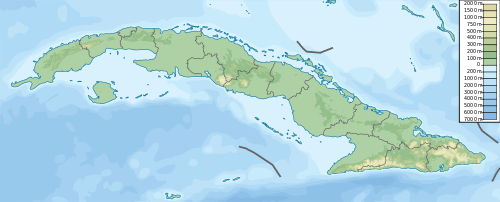Jardines de la Reina
Jardines de la Reina (English: Gardens of the Queen) is an archipelago in the southern part of Cuba, in the provinces of Camagüey and Ciego de Ávila.
| Jardines de la Reina | |
|---|---|
IUCN category II (national park) | |
 Location of Jardines de la Reina in Cuba | |
| Location | |
| Nearest city | Santa Cruz del Sur |
| Coordinates | 20°49′N 78°55′W |
| Area | 2,170 km2 (840 sq mi)[1] |
It was named by Christopher Columbus to honour the Queen of Spain, Isabella I of Castile. Since 1996 a marine reserve was established covering a large swath of the archipelago.[2] In 2010, Jardines de la Reina was established as a national park (Spanish: Parque Nacional Jardines de la Reina).[3] With an area of 2,170 km2 (840 sq mi), it is one of Cuba's largest protected areas.[1]
Geography
It is located in the Caribbean Sea, between the Gulf of Ana Maria (north-west), Gulf of Guacanayabo (south) and Caballones Channel (west). It extends on a general north-west to south-east direction, paralleling the Cuban coast for 150 km (93 mi) from Cayo Breton to Cayos Mordazo. Cuba's second largest archipelago (smaller only than Jardines del Rey), it is formed by more than 600 cays and islands. Other cays in the archipelago include Caguamas, Cayos Cinco Balas, Cayo Anclitas, Cayo Algodon Grande, Cayos Pingues and Cayo Granada. Part of the archipelago is also known as Laberinto de las Doce Leguas (The Labyrinth of the Twelve Leagues)
Table of Islands
| Nr. 1) | Island | Other cays and features | Area (km²) | Population (Census 2012 official) |
| 1 | Cayo Algodon Grande | 3.70 | 0 | |
| 2 | Cayo Anclitas | Punta Piloto | 4.50 | 0 |
| 3 | Cayo Breton | 6.70 | 0 | |
| 4 | Cayo Caballones | 16.50 | 0 | |
| 5 | Cayo Cabeza Del Este | 6.36 | 0 | |
| 6 | Cayo Caguamas | 7.86 | 0 | |
| 7 | Cayo Grande | 26.80 | 0 | |
| 8 | Cayos Ana Maria | Cayo Tio Joaquin, Arenas, Balandras, Ana Maria, Caoba, Campito, Guasimas, Flamenco, Dos Hermanos, Guinea, Obispo, Laguna, Encantado, Joroba, | 14.76 | 0 |
| 9 | Cayos Bahia de Casilda | Guayo, Tobaco, Puga, Machos | 1.00 | 0 |
| 10 | Cayos Cinco Balas | 13.50 | 0 | |
| 11 | Cayos Granada | Corua, Sardines, Caoba, Guasa, Rancho Viejo, Inglesitos, Pilon | 16.63 | 0 |
| 12 | Cayos Media Luna | Culebra, Loma, Rabihorcado | 7.10 | 0 |
| 13 | Cayos Mordazo | Ronquitto, Almacigo, Lena, Muchacho, Largo, Punta Infierno, Yana, Playa Blanca, Carabela, Pitajaya, Las Bolas, | 9.30 | 0 |
| 14 | Cayos Pingues | Cottoro, Macho, Rancho Alegre, Vivero, Anton, Chocolate, | 20.46 | 0 |
| 15 | More Islands | Alcatracito, Paloma, Cuervo, Algodoncito, Manuel Gomez, Santa Maria, Zaza de Afuera, Piedra Chica, Cachiboca, Indio, Carabinerro, Laberinto, Boca Seca, Campo Santo | 20.00 | 0 |
| Jardines de la Reina | Cayo Blanco, Tio Joaquin | 175.00 | 0 |
1) The Islands area and population data retrieved from the 2012 census.
Fishing
The archipelago is a popular destination for diving and sport fly-fishing. Only catch and release fly-fishing and a limited, well-regulated lobster fishery is allowed n the park, although many other fisheries occur suroounding the park and close to cays out of the park limits. It used to be one of Fidel Castro's favorite fishing spots. Species of fish found here include Cubera snapper, Bonefish, Yellowfin grouper, Black grouper, Atlantic goliath grouper as well as Strombus gigas (the large Caribbean conch) and Whale shark.[1] Besides being an extraordinary site for fly fishing, one its main attractions for diving is the abundance of reef sharks.
Diving
Jardines de la Reina (The Gardens of the Queen) is one of the most popular scuba destinations of Cuba. The underwater landscapes include canyons, pinnacles and caves. Healthy mangroves, sponges and black corals cover the reef. The Jardines de la Reina also host numerous silky and Caribbean reef sharks. In the mangroves labyrinth it’s possible to find crocodiles and snorkel with them.
See also
References
- National Council for Cultural Heritage. "Jardines de la Reina". Archived from the original on 2007-08-21. Retrieved 2007-10-08.
- "Jardines de la Reina". 2018. Retrieved 2018-09-13.
- "Legislacion Jardines de la Reina" (PDF). www.medioambiente.cu (in Spanish). Agencia de Medio Ambiente. 2010. Retrieved 13 September 2018.